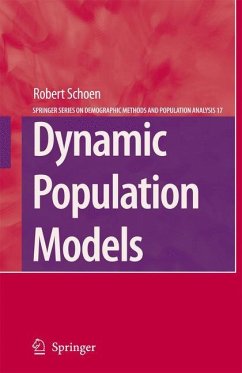Dynamic Population Models is the first book to comprehensively discuss and synthesize the emerging field of dynamic modeling, i.e. the analysis and application of population models that have changing vital rates. Incorporating the latest research, it includes thorough discussions of population growth and momentum under gradual fertility declines, the impact of changes in the timing of events on fertility measures, and the complex relationship between period and cohort measures. Recently developed models for the analysis of changing mortality are examined, and generalizations of Lotka's fixed rate stable population model are developed and applied.
The book is well organized and clearly written so that it is accessible to those with only a minimal knowledge of calculus. It begins with a review of fixed rate population models, from the basic life table to multistate stable populations. The process of convergence to stability is described, and the regularities underlying change in the size and composition of any population are explored. Techniques for estimating rates from multistate population distributions are presented, and new multi-age, multistate dynamic models are developed. Building on the logical closure of demographic models and the close relationship between population stocks and flows, the book sets forth the latest approaches for capturing population change in a world experiencing profound demographic transformations.
The book is well organized and clearly written so that it is accessible to those with only a minimal knowledge of calculus. It begins with a review of fixed rate population models, from the basic life table to multistate stable populations. The process of convergence to stability is described, and the regularities underlying change in the size and composition of any population are explored. Techniques for estimating rates from multistate population distributions are presented, and new multi-age, multistate dynamic models are developed. Building on the logical closure of demographic models and the close relationship between population stocks and flows, the book sets forth the latest approaches for capturing population change in a world experiencing profound demographic transformations.
From the reviews: "The book is a rich collection of results on demographic models addressing the implications of the dynamics of demographic rates. ... is provided with a list of thoroughly prepared exercises, which will be helpful for those who might use the book for study or for teaching mathematical demography. All appendices are very useful supplements. ... the book is a good addition to the Springer Series. I would recommend it to those interested in mathematical demography both for reading, and as a collection of useful results." (Dalkhat M. Ediev, European Journal of Population, Vol. 24, 2008) "With over 100 end of chapter exercises ... and a very clear style, it is accessible to graduate students in demography with a good background in linear algebra and differential and difference equations. For experts, it provides a fine survey of the most used mathematical models in demography, with many practical applications. ... I learned a lot from reading this book, and if you are interested in mathematical demography, you will too." (Roy Gardner, Zentralblatt MATH, Vol. 1151, 2009)








